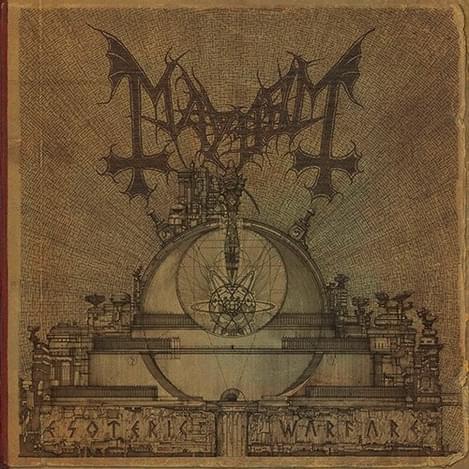Mayhem - Esoteric Warfare
"Esoteric Warfare"

As you may very well be aware, the lineup that recorded Mayhem’s first (and best) album De Mysteriis Dom Sathanas also featured Attila and Hellhammer, but also a guy named Count Grishnackh and another called Euronymous – their story will go down in black metal lore forever, for reasons that I’d rather not dredge up again here. So, with two of the original, greatest lineup involved, expectations for Esoteric Warfare should be more feverish than they are. The reason for the lack of fanfare surrounding Mayhem’s return is their completely divisive, fanbase-splitting 2007 release Ordo Ad Chao, which completely did away with the notion of ‘black metal’ as a millstone around the collective neck of the band. The production was fuller, heavier and deeper than many fans of the ‘necro’ (i.e. reed-thin, barely audible, treble-heavy, bass-less) production could stomach, leading many of them to write thing off as a death metal record and Mayhem as traitors. These faceless detractors were quickly ignored by fans of heavy metal, and the record was rightly celebrated as a monumental achievement by the metal community and mainstream media outlets galore.
Esoteric Warfare follows much in the same vein as Ordo Ad Chao – the sound is bass-heavy and unbelievably clear, all of the instruments are completely distinguishable from each other and the vocals… Attila’s growls, bellows and screeches are harsher and darker than ever. The ‘sound’ straddles the fine line (and believe me, there is one) between death metal and black metal with such aplomb that you begin to wonder why more bands are making use of this stylistic template.
The record opens with the white-hot, electric-burn intensity of “Watcher”, where Hellhammer’s position at the forefront of the Mayhem sound is immediately apparent. From the opening section, where his double-tap kick-drum attack reaches its signature warp-speed pace, to the more atmospheric, textural middle passage where his drums become (and say it quietly) groovy, he quite literally blasts away any notion of Mayhem’s lustre dulling with age.
Next tune “Psywar” is, crazily, even more intense than its predecessor: Attila’s maniacal growling weaves in and out of the black miasma thrashing away beneath it – Teloch’s relentless, bee-drone shred and Necrobutcher’s gut-bothering bottom-end pummel combine perfectly with Hellhammer’s signature jackhammer ferocity. “Trinity” and “Pandaemon” both bring different musical textures to the record – the former plumbs the lower recesses of Attila’s vocal range, and the latter constantly shifts between grindcore speed and death metal savagery with equal success.
There are many other delightful cuts on the record, not least the incredible “Corpse of Care”, which appears towards the end. A strung-out, doomy introduction contrasts well with the short, razor sharp thrashing passages. The drawn-out terror that the guys imbue the track with is staggering – their collective aging hasn’t blunted the cutting edge of their most aggressive tracks.
The wintry, frostbitten vibe of “Posthuman” is as close to the mood of Retro Black Metal® as purists are likely to find on the record - and at times it even sounds progressive. Its charred-black menace is directly influenced by the pummelling atmospheric approach of iconic forebears Celtic Frost. Aion Suntalia closes out the record with a flurry of chunky riffs and Hellhammer’s most subdued – and hence most groovy - performance on the record.
Esoteric Warfare won’t be seen as Mayhem’s best album – there was never any chance of that. However, it’s as good as its predecessor, and every bit as vile and crushing as you’d expect. The closest comparison that can be drawn here is Carcass’ Surgical Steel – a modern version of a classic sound, reinterpreted by the pioneers to re-educate the upstarts. This is black metal, this is Mayhem.
Get the Best Fit take on the week in music direct to your inbox every Friday

Bon Iver
SABLE, fABLE

Mamalarky
Hex Key

Florist
Jellywish





